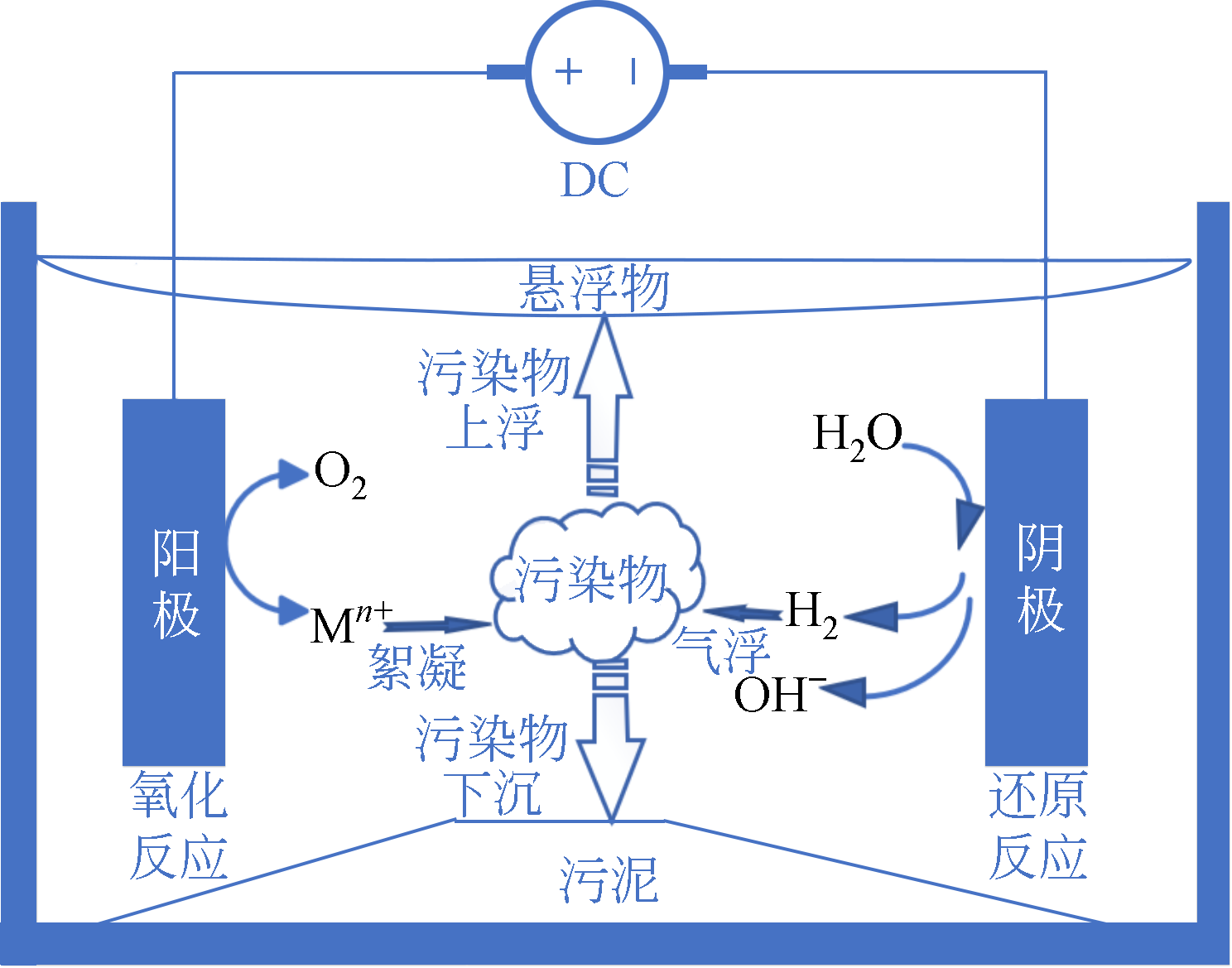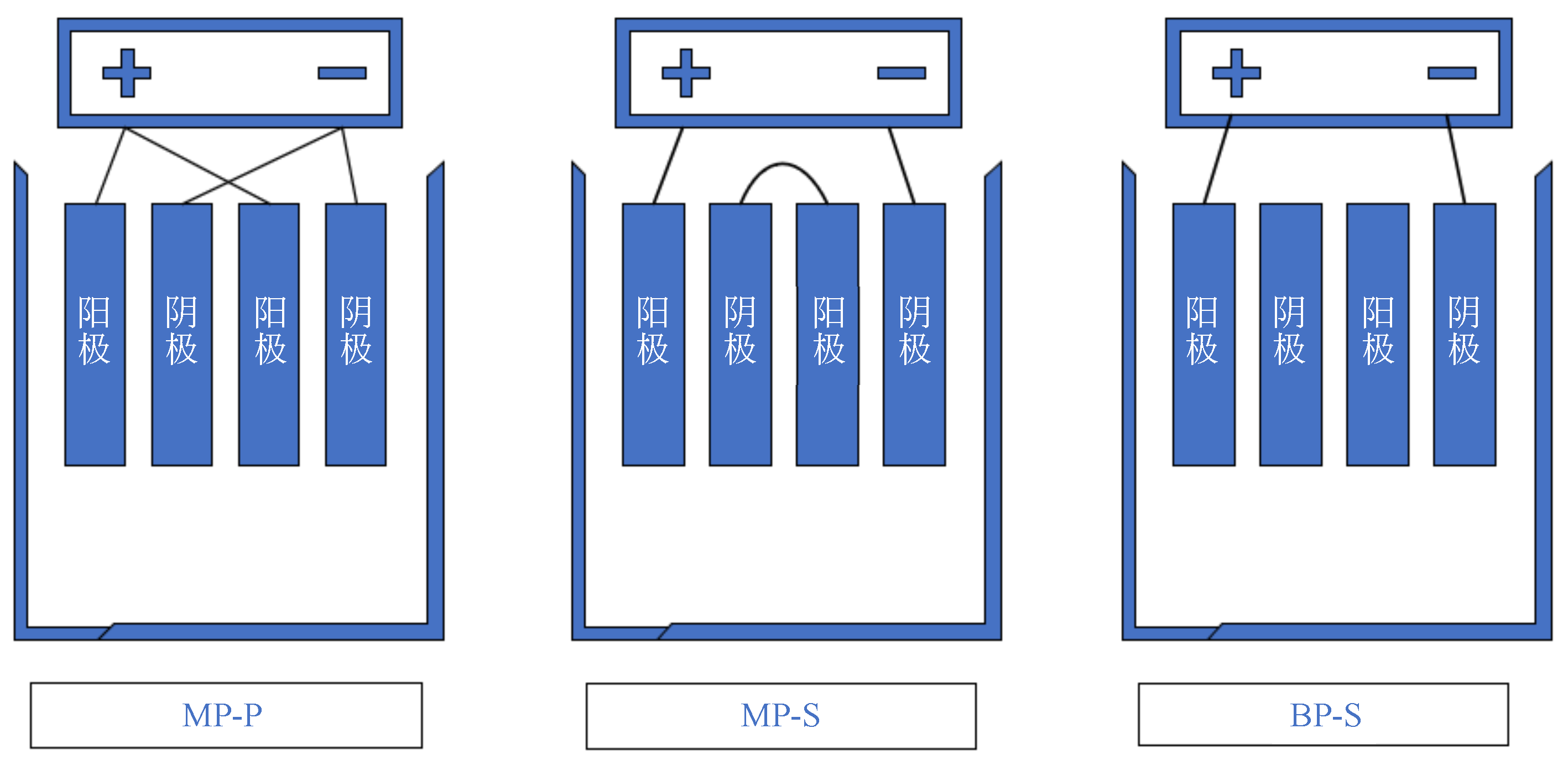Chemical Industry and Engineering Progress ›› 2020, Vol. 39 ›› Issue (S2): 329-335.DOI: 10.16085/j.issn.1000-6613.2020-0877
• Resources and environmental engineering • Previous Articles Next Articles
Research progress and challenge of electrocoagulation technology in water treatment
Jie ZHOU1,2( ), Xiaosan SONG1,2(
), Xiaosan SONG1,2( ), Sanfan WANG1,2
), Sanfan WANG1,2
- 1.School of Environment and Municipal Engineering, Lanzhou Jiaotong University, Lanzhou 730070, Gansu, China
2.Engineering Center of Water Resources Comprehensive Utilization, Ministry of Education, Lanzhou 730070, Gansu, China
-
Received:2020-05-21Online:2020-11-17Published:2020-11-20 -
Contact:Xiaosan SONG
水处理电絮凝技术的研究进展与挑战
- 1.兰州交通大学环境与市政工程学院,甘肃 兰州 730070
2.寒旱地区水资源综合利用教育部工程中心,甘肃 兰州 730070
-
通讯作者:宋小三 -
作者简介:周杰(1998—),男,硕士研究生,研究方向为电化学水处理。E-mail:841095337@qq.com 。 -
基金资助:国家自然科学基金(51804150)
CLC Number:
Cite this article
Jie ZHOU, Xiaosan SONG, Sanfan WANG. Research progress and challenge of electrocoagulation technology in water treatment[J]. Chemical Industry and Engineering Progress, 2020, 39(S2): 329-335.
周杰, 宋小三, 王三反. 水处理电絮凝技术的研究进展与挑战[J]. 化工进展, 2020, 39(S2): 329-335.
share this article
Add to citation manager EndNote|Ris|BibTeX
URL: https://hgjz.cip.com.cn/EN/10.16085/j.issn.1000-6613.2020-0877
| 1 | CHEN G. Electrochemical technologies in wasterwater treatment[J]. Separation and Purification Technology, 2004, 38(1): 11-41. |
| 2 | 牛庆林, 曹顺安. 电絮凝法预处理船舶生活污水研究[J]. 应用化工, 2018, 47(3): 541-544, 547. |
| NIU Qinglin, CAO Shunan. Study on the pretreatment of ship sewage by electrocoagulation technology[J]. Applied chemistry, 2018,47 (3): 541-544, 547. | |
| 3 | WANG Y, YAN J, LI Z, et al. The mechanism of removing the organic matter in heavy oil sewage by the electric flocculation method[J]. Petroleum Science and Technology, 2014, 32(13): 1529-1536. |
| 4 | 张石磊, 江旭佳, 洪国良, 等. 电絮凝技术在水处理中的应用[J]. 工业水处理, 2013, 33(1): 10-14, 19. |
| ZHANG Shilei, JIANG Xujia, HONG Guoliang, et al. Application of electrocoagulation technology to water treatment[J]. Industrial Water Treatment, 2013,33 (1): 10-14, 19. | |
| 5 | LACASA E, CAÑIZARES P, SÁEZ C, et al. Removal of nitrates from groundwater by electrocoagulation[J]. Chemical Engineering Journal, 2011, 171(3): 1012-1017. |
| 6 | MHATRE S, VIVACQUA V, GHADIRI M, et al. Electrostatic phase separation: a review[J]. Chemical Engineering Research and Design, 2015, 96(2): 177-195. |
| 7 | KUOKKANEN V, KUOKKANEN T, RAMO J, et al. Recent applications of electrocoagulation in treatment of water and wastewater—A review[J]. Green and Sustainable Chemistry, 2013, 3(2): 89-121. |
| 8 | VEPSäLäINEN M, SILLANPÄÄ M. Electrocoagulation in the treatment of industrial waters and wastewaters[M]. Advanced Water Treatment. Elsevier, 2020: 1-78. |
| 9 | MOUEDHEN G, FEKI M, WERY M D P, et al. Behavior of aluminum electrodes in electrocoagulation process[J]. Journal of Hazardous Materials, 2008, 150(1): 124-135. |
| 10 | HOLT P K, BARTON G W, MITCHELL C A. The future for electrocoagulation as a localised water treatment technology[J]. Chemosphere, 2005, 59(3): 355-367. |
| 11 | BAZRAFSHAN E, MOHAMMADI L, ANSARIMOGHADDAM A, et al. Heavy metals removal from aqueous environments by electrocoagulation process—A systematic review[J]. Iranian Journal of Environmental Health Science & Engineering, 2015, 13(1): 74-89. |
| 12 | MOLLAH M Y, MORKOVSKY P, GOMES J A, et al. Fundamentals, present and future perspectives of electrocoagulation[J]. Journal of hazardous materials, 2004, 114(1/2/3): 199-210. |
| 13 | 刘兴. 电絮凝法同时去除地下水中氟和镉研究[D]. 广州: 华南理工大学, 2019. |
| LIU Xing. Simultaneous Removal of fluorine and cadmium from groundwater by electrocoagulation[D]. Guangzhou:South China University of technology, 2019. | |
| 14 | HASHIM K S, SHAW A, KHADDAR R AL, et al. Iron removal, energy consumption and operating cost of electrocoagulation of drinking water using a new flow column reactor[J]. Journal of environmental management, 2017, 189: 98-108. |
| 15 | 胡维, 戴友芝, 刘凯, 等. 基于响应面的电絮凝除As(Ⅲ)研究[J]. 水处理技术, 2014,40(1): 47-51, 55. |
| HU Wei, DAI Youzhi, LIU Kai, et al. Study on as (Ⅲ) removal by electrocoagulation based on response surface[J]. Water Treatment Technology, 2014, 40(1): 47-51, 55. | |
| 16 | KHANDEGAR V, SAROHA A K. Electrocoagulation for the treatment of textile industry effluent—A review[J]. Journal of Environmental Management, 2013, 128: 949-963. |
| 17 | MALINOVIC B N, PAVLOVIC M G. Decolorization of reactive violet 5 dye in textile wastewater by electrocoagulation[J]. Journal of Electrochemical Science and Engineering, 2016, 6(1): 67-75. |
| 18 | 丁春生, 徐洋洋, 陈姗, 等. 电絮凝法处理铬黑T染料废水的研究[J]. 印染助剂, 2013, 30(6): 39-42. |
| DING Chunsheng, XU Yangyang, CHEN Shan, et al. Study on treatment of Eriochrome Black T dye wastewater with electro coagulation method[J]. Printing and dyeing auxiliaries, 2013,30 (6): 39-42. | |
| 19 | 丁学姣. 电絮凝强化处理船舶生活污水研究[D]. 哈尔滨: 哈尔滨工程大学, 2018. |
| DING Xuejiao. Research on enhancing treatment of ship domestic sewage by electro-coagulation [D].Harbin:Harbin Engineering University, 2018. | |
| 20 | EL-TAWEEL Y A, NASSEF E M, ELKHERIANY I, et al. Removal of Cr (Ⅵ) ions from waste water by electrocoagulation using iron electrode[J]. Egyptian Journal of Petroleum, 2015, 24(2): 183-192. |
| 21 | 谭超雄, 曾晨辉, 梁继业, 等. 电絮凝处理含铜铬电镀废水的研究[J]. 山东化工, 2015, 44(13): 156-157, 162. |
| TAN Chaoxiong, ZENG Chenhui, LIANG Jiye, et al. Study on electrocoagulation of electroplating wastewater containing copper and chromium[J]. Shandong Chemical Industry, 2015, 44 (13): 156-157, 162. | |
| 22 | NGUYEN D D, NGO H H, GUO W, et al. Can electrocoagulation process be an appropriate technology for phosphorus removal from municipal wastewater[J]. Science of The Total Environment, 2016, 563: 549-556. |
| 23 | 来伟良. 电絮凝法处理含磷废水的试验研究[J]. 能源环境保护, 2015, 29(4): 12-15. |
| LAI Weiliang. Study on phosphorus wasterwater with electro-coagulation[J]. Energy and Environmental Protection, 2015, 29 (4): 12-15. | |
| 24 | FRANCO D, LEE J, ARBELAEZ S, et al. Removal of phosphate from surface and wastewater via electrocoagulation[J]. Ecological Engineering, 2017, 108: 589-596. |
| 25 | AN C, HUANG G H, YAO Y, et al. Emerging usage of electrocoagulation technology for oil removal from wastewater: a review[J]. Science of The Total Environment, 2017, 579: 537-556. |
| 26 | 刘杨, 李玉星, 蒋文明, 等. 电絮凝技术处理油田污水的影响因素实验研究[J].湖南大学学报(自然科学版), 2017, 44(12): 142-149. |
| LIU Yang, LI Yuxing, JIANG Wenming, et al. Experimental study on influence factors of oil field wastewater[J]. Journal of Hunan University (Natural Science Edition), 2017, 44 (12): 142-149. | |
| 27 | GOBBI L C, NASCIMENTO I L, MUNIZ E P, et al. Electrocoagulation with polarity switch for fast oil removal from oil in water emulsions[J]. Journal of Environmental Management, 2018, 213: 119-125. |
| 28 | DEMIRCI Y, PEKEL L C, ALPBAZ M. Investigation of different electrode connections in electrocoagulation of textile wastewater treatment[J]. International Journal of Electrochemical Science, 2015, 10(3): 2685-2693. |
| 29 | KOBYA M, DEMIRBAS E. Evaluations of operating parameters on treatment of can manufacturing wastewater by electrocoagulation[J]. Journal of Water Process Engineering, 2015, 8: 64-74. |
| 30 | KHANDEGAR V, SAROHA A K. Electrocoagulation for the treatment of textile industry effluent—A review[J]. Journal of Environmental Management, 2013, 128: 949-963. |
| 31 | KOBYA M, GENGEC E, DEMIRBAS E. Operating parameters and costs assessments of a real dyehouse wastewater effluent treated by a continuous electrocoagulation process[J]. Chemical Engineering and Processing: Process Intensification, 2016, 101: 87-100. |
| 32 | TROMPETTE J L, VERGNES H. On the crucial influence of some supporting electrolytes during electrocoagulation in the presence of aluminum electrodes[J]. Journal of Hazardous Materials, 2009, 163(2/3): 1282-1288. |
| 33 | 费琼, 王少坡, 罗伟, 等. 电絮凝法在水处理过程中影响因素研究现状[J]. 工业水处理, 2016, 36(12):16-21. |
| FEI Qiong, WANG Shaopo, LUO Wei, et al. Current situation of the research on the influencing factors of electro-coagulation method in the process of water treatment[J]. Industrial Water Treatment, 2016,36 (12): 16-21. | |
| 34 | MANSOORIAN H J, MAHVI A H, JAFARI A J. Removal of lead and zinc from battery industry wastewater using electrocoagulation process: influence of direct and alternating current by using iron and stainless steel rod electrodes[J]. Separation and Purification Technology, 2014, 135: 165-175. |
| 35 | GATSIOS E, HAHLADAKIS J N, GIDARAKOS E. Optimization of electrocoagulation (EC) process for the purification of a real industrial wastewater from toxic metals[J]. Journal of Environmental Management, 2015, 154: 117-127. |
| 36 | LINARES-HERNáNDEZ I, BARRERA-DíAZ C, ROA-MORALES G, et al. Influence of the anodic material on electrocoagulation performance[J]. Chemical Engineering Journal, 2009, 148(1): 97-105. |
| 37 | BARRERA-DíAZ C, ROA-MORALES G, ÁVILA-CÓRDOBA L, et al. Electrochemical treatment applied to food-processing industrial wastewater[J]. Industrial & Engineering Chemistry Research, 2006, 45(1): 34-48. |
| 38 | 冯利, 汤鸿霄. 铝盐最佳混凝形态及最佳pH范围研究[J]. 环境化学, 1998(2): 163-169. |
| FENG Li, TANG Hongxiao. Study on the optimal coagulation form and pH range of aluminum salt[J]. Environmental Chemistry, 1998 (2): 163-169. | |
| 39 | MORENO A C H, COCKE D L, GOMES J A, et al. Electrochemical Reactions for Electrocoagulation Using Iron Electrodes[J]. Industrial & Engineering Chemistry Research, 2009, 48(4): 2275-2282. |
| [1] | ZHANG Mingyan, LIU Yan, ZHANG Xueting, LIU Yake, LI Congju, ZHANG Xiuling. Research progress of non-noble metal bifunctional catalysts in zinc-air batteries [J]. Chemical Industry and Engineering Progress, 2023, 42(S1): 276-286. |
| [2] | HU Xi, WANG Mingshan, LI Enzhi, HUANG Siming, CHEN Junchen, GUO Bingshu, YU Bo, MA Zhiyuan, LI Xing. Research progress on preparation and sodium storage properties of tungsten disulfide composites [J]. Chemical Industry and Engineering Progress, 2023, 42(S1): 344-355. |
| [3] | ZHANG Jie, BAI Zhongbo, FENG Baoxin, PENG Xiaolin, REN Weiwei, ZHANG Jingli, LIU Eryong. Effect of PEG and its compound additives on post-treatment of electrolytic copper foils [J]. Chemical Industry and Engineering Progress, 2023, 42(S1): 374-381. |
| [4] | WANG Ying, HAN Yunping, LI Lin, LI Yanbo, LI Huili, YAN Changren, LI Caixia. Research status and future prospects of the emission characteristics of virus aerosols in urban wastewater treatment plants [J]. Chemical Industry and Engineering Progress, 2023, 42(S1): 439-446. |
| [5] | XU Chunshu, YAO Qingda, LIANG Yongxian, ZHOU Hualong. Research progress on functionalization strategies of covalent organic frame materials and its adsorption properties for Hg(Ⅱ) and Cr(Ⅵ) [J]. Chemical Industry and Engineering Progress, 2023, 42(S1): 461-478. |
| [6] | WANG Chen, BAI Haoliang, KANG Xue. Performance study of high power UV-LED heat dissipation and nano-TiO2 photocatalytic acid red 26 coupling system [J]. Chemical Industry and Engineering Progress, 2023, 42(9): 4905-4916. |
| [7] | WANG Yaogang, HAN Zishan, GAO Jiachen, WANG Xinyu, LI Siqi, YANG Quanhong, WENG Zhe. Strategies for regulating product selectivity of copper-based catalysts in electrochemical CO2 reduction [J]. Chemical Industry and Engineering Progress, 2023, 42(8): 4043-4057. |
| [8] | LIU Yi, FANG Qiang, ZHONG Dazhong, ZHAO Qiang, LI Jinping. Cu facets regulation of Ag/Cu coupled catalysts for electrocatalytic reduction of carbon dioxide [J]. Chemical Industry and Engineering Progress, 2023, 42(8): 4136-4142. |
| [9] | ZHANG Yajuan, XU Hui, HU Bei, SHI Xingwei. Preparation of NiCoP/rGO/NF electrocatalyst by eletroless plating for efficient hydrogen evolution reaction [J]. Chemical Industry and Engineering Progress, 2023, 42(8): 4275-4282. |
| [10] | WANG Shuaiqing, YANG Siwen, LI Na, SUN Zhanying, AN Haoran. Research progress on element doped biomass carbon materials for electrochemical energy storage [J]. Chemical Industry and Engineering Progress, 2023, 42(8): 4296-4306. |
| [11] | LI Haidong, YANG Yuankun, GUO Shushu, WANG Benjin, YUE Tingting, FU Kaibin, WANG Zhe, HE Shouqin, YAO Jun, CHEN Shu. Effect of carbonization and calcination temperature on As(Ⅲ) removal performance of plant-based Fe-C microelectrolytic materials [J]. Chemical Industry and Engineering Progress, 2023, 42(7): 3652-3663. |
| [12] | XU Wei, LI Kaijun, SONG Linye, ZHANG Xinghui, YAO Shunhua. Research progress of photocatalysis and co-electrochemical degradation of VOCs [J]. Chemical Industry and Engineering Progress, 2023, 42(7): 3520-3531. |
| [13] | YANG Hongmei, GAO Tao, YU Tao, QU Chengtun, GAO Jiapeng. Treatment of refractory organics sulfonated phenolic resin with ferrate [J]. Chemical Industry and Engineering Progress, 2023, 42(6): 3302-3308. |
| [14] | ZHANG Peng, PAN Yuan. Progress of single atom catalysts in electrocatalytic oxygen reduction to hydrogen peroxide [J]. Chemical Industry and Engineering Progress, 2023, 42(6): 2944-2953. |
| [15] | CHEN Shaohua, WANG Yihua, HU Qiangfei, HU Kun, CHEN Li’ai, LI Jie. Research progress on detection of Cr(Ⅵ) by electrochemically modified electrode [J]. Chemical Industry and Engineering Progress, 2023, 42(5): 2429-2438. |
| Viewed | ||||||
|
Full text |
|
|||||
|
Abstract |
|
|||||

